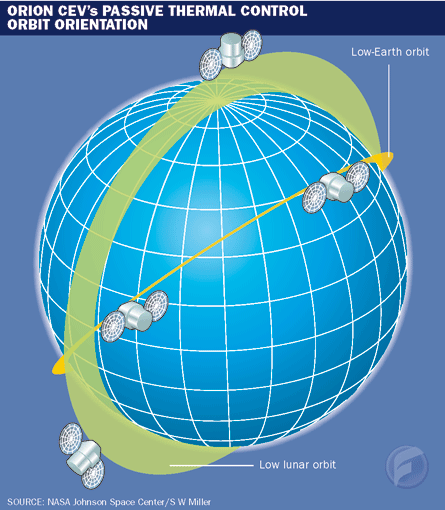NASA's Orion crew exploration vehicle could be orbiting the Earth for six days after it is docked with the Lunar Lander.
There will also be three lunar orbit insertion burns, compared with Apollo's one on re-entry the service module's debris will crash off the Californian coast.
NASA is worried that Orion's launch abort system's glassfibre boost protection cover could bump and damage the CEV's crew module backshell thermal protection system (TPS) during separation, according to reports obtained by Flight International, flightglobal.com's sister publication.
With details of Orion's development emerging from sources other than the space agency's official quarterly reports, it appears that the CEV may use technology from the 1960s Atlas Agena automated docking tracking system.
 |
|---|
However, Orion will certainly use short-range optical cameras and light detection and ranging units (lidar) for manual and automated rendezvous and docking operations when the CEV is not in its tail-to-the-Sun orientation at an orbital inclination of 45°, for passive thermal control.
For automated rendezvous and docking it will use two short-range optical cameras, by US image sensor specialist AltaSens, each with three two-megapixel optical sensor units, and Canadian company MDA's lidar, previously tested by the US Air Force Research Laboratory/Boeing Experimental Satellite System (XSS)-11 spacecraft.
In low-Earth orbit Orion will also use three General Dynamics Viceroy model GPS receivers with two antennas each, for velocity state vector updates.
But for all the progress NASA is still concerned about the boost protection cover hitting the crew module backshell during ascent. An Orion project office document dated in September says: "There are concerns about the boost protection cover damaging the thermal protection system coating during separation."
The agency has launch abort system flight plans and as of August its Dryden Flight Research Center was incorporating a launch abort system/boost protection cover and crew module separation into its PA-1 test, which is planned for September next year at White Sands Missile Range in New Mexico.
While Orion is to go first to the International Space Station, ongoing analyses are examining mission timing constraints due to possible lunar landing sites' lighting levels.
With the requirement to land anywhere on the Moon, unlike Apollo's equatorial zones limitations, the Orion project office's flight dynamics team has determined that the combined exploration vehicle and lander will have to loiter in low-Earth orbit, potentially for up to six days, waiting for the correct moment for trans-lunar injection to achieve the right orbital inclination following three lunar orbit insertion burns.
For guidance, Orion will have three Mylar blanket-protected Goodrich HD1005 model star trackers. Once at the Moon the CEV will again orbit in a tail-to-the-Sun orientation for thermal control, but this time in a polar inclination of 85-90°, while the lander goes to the outpost at either pole.
Returning home, once in the Earth's atmosphere Orion will use three Honeywell LG-1237 Smart PT model pressure transducers to detect atmospheric pressure and therefore altitude, for chute deployment and other landing system cues.
NASA's sonic boom assessments for the re-entering crew module and service module show debris from the service module's break up at 225,000ft (68,600m) crashing out to sea off the Californian coast, for ISS and lunar missions.
The town of Rosamond, California is below the 0.41lb/ft² (2kg/m²) maximum overpressure region of the crew module's Edwards AFB landing descent path, following a skip re-entry from the Moon. The Space Shuttle's Edwards AFB trajectory maximum overpressure is 1.28lb/ft².
Source: Flight International
















